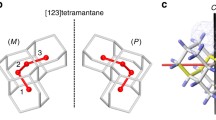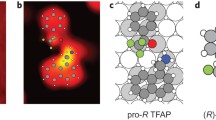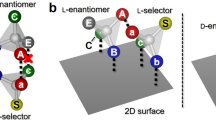Abstract
The molecular-level identification of a chiral recognition process of phthalocyanine (Pc) was studied on a Cu(100) surface by scanning tunneling microscopy (STM). STM revealed that a chiral Pc molecule forms a series of metastable dimer configurations with other Pc molecules. Eventually, the Pc molecule recognizes another Pc molecule with the same chirality to form a stable dimer configuration. Homochiral dimers were found on the Cu surface, demonstrating the chiral specificity of Pc dimerization. The mechanism for this chiral recognition process is identified, disclosing the critical role of the particular adsorption geometry of the chiral dimers on the Cu surface.

Similar content being viewed by others
References
Barlow, S. M.; Raval, R. Complex organic molecules at metal surfaces: Bonding, organisation and chirality. Surf. Sci. Rep. 2003, 2, 201–341.
Vijayaraghavan, A.; Hennrich, F.; Stü rzl, N.; Engel, M.; Ganzhorn, M.; Oron-Carl, M.; Marquardt, C. W.; Dehm, S.; Lebedkin, S.; Kappes, M. M. et al. Toward single-chirality carbon nanotube device arrays. ACS Nano 2010, 2, 2748–2754.
Speranza, M.; Rondino, F.; Satta, M.; Paladini, A.; Giardini, A.; Catone, D.; Piccirillo, S. Molecular and supramolecular chirality: R2PI spectroscopy as a tool for the gas-phase recognition of chiral systems of biological interest. Chirality 2009, 2, 119–144.
Tahara, K.; Yamaga, H.; Ghijsens, E.; Inukai, K.; Adisoejoso, J.; Blunt, M. O.; De Feyter, S.; Tobe, Y. Control and induction of surface-confined homochiral porous molecular networks. Nat. Chem. 2011, 2, 714–719.
Raval, R. Chiral expression from molecular assemblies at metal surfaces: Insights from surface science techniques. Chem. Soc. Rev. 2009, 2, 707–721.
Ernst, K.-H. Supramolecular surface chirality. In Topics in Current Chemistry: Supramolecular Chirality; Springer Berlin: Heidelberg, 2006; pp 209–252.
Lingenfelder, M.; Tomba, G.; Costantini, G.; Ciacchi, L. C.; De Vita, A.; Kern, K. Tracking the chiral recognition of adsorbed dipeptides at the single-molecule level. Angew. Chem., Int. Ed. 2007, 2, 4492–4495.
Mugarza, A.; Lorente, N.; Ordejón, P.; Krull, C.; Stepanow, S.; Bocquet, M.-L.; Fraxedas, J.; Ceballos, G.; Gambardella, P. Orbital specific chirality and homochiral self-assembly of achiral molecules induced by charge transfer and spontaneous symmetry breaking. Phys. Rev. Lett. 2010, 105, 115702.
Chen, F.; Chen, X.; Liu, L. C.; Song, X.; Liu, S. Y.; Liu, J.; Ouyang, H. P.; Cai, Y. X.; Liu, X. Q.; Pan, H. B.; et al. Chiral recognition of zinc phthalocyanine on Cu(100) surface. Appl. Phys. Lett. 2012, 100, 081602.
Fischer, E. Einfluss der configuration auf die wirkung der enzyme. Ber. Dtsch. Chem. Ges. 1894, 2, 2985–2993.
Easson, L. H.; Stedman, E. Studies on the relationship between chemical constitution and physiological action: Molecular dissymmetry and physiological activity. Biochem. J. 1933, 2, 1257–1266.
Kresse, G.; Furthmü ller, J. Efficiency of ab-initio total energy calculations for metals and semiconductors using a planewave basis set. Comput. Mater. Sci. 1996, 2, 15–50.
Kresse, G.; Furthmü ller, J. Efficient iterative schemes for ab initio total-energy calculations using a plane-wave basis set. Phys. Rev. B 1996, 2, 11169–11186.
Kresse, G.; Joubert, D. From ultrasoft pseudopotentials to the projector augmented-wave method. Phys. Rev. B 1999, 2, 1758–1775.
Perdew, J. P.; Burke, K.; Ernzerhof, M. Generalized gradient approximation made simple. Phys. Rev. Lett. 1996, 2, 3865–3868.
Perdew, J. P.; Burke, K.; Ernzerhof, M. Generalized gradient approximation made simple. [Phys. Rev. Lett. 77, 3865 (1996)]. Phys. Rev. Lett. 1997, 78, 1396.
Grimme, S. Semiempirical GGA-type density functional constructed with a long-range dispersion correction. J. Comput. Chem. 2006, 2, 1787–1799.
Bucko, T.; Hafner, J.; Lebègue, S.; Ángyán, J. G. Improved description of the structure of molecular and layered crystals: Ab initio DFT calculations with van der Waals corrections. J. Phys. Chem. A 2010, 2, 11814–11824.
Amsalem, P.; Giovanelli, L.; Themlin J. M.; Angot, T. Electronic and vibrational properties at the ZnPc/Ag(110) interface. Phys. Rev. B 2009, 79, 235426.
Kitamura, S.; Sato, T.; Iwatsuki, M. Observation of surface reconstruction on silicon above 800 °C using the STM. Nature 1991, 2, 215–217.
Nakakura, C. Y.; Phanse, V. M.; Zheng, G.; Bannon, G.; Altman, E. I.; Lee, K. P. A high-speed variable-temperature ultrahigh vacuum scanning tunneling microscope. Rev. Sci. Instrum. 1998, 2, 3251–3258.
Buchner, F.; Xiao, J.; Zillner, E.; Chen, M.; Rö ckert, M.; Ditze, S.; Stark, M.; Steinrü ck, H.-P.; Gottfried, J. M.; Marbach, H. Diffusion, rotation, and surface chemical bond of individual 2H-tetraphenylporphyrin molecules on Cu(111). J. Phys. Chem. C 2011, 2, 24172–24177.
Author information
Authors and Affiliations
Corresponding authors
Rights and permissions
About this article
Cite this article
Xu, R., Liu, J., Chen, F. et al. Room-temperature tracking of chiral recognition process at the single-molecule level. Nano Res. 8, 3505–3511 (2015). https://doi.org/10.1007/s12274-015-0850-7
Received:
Revised:
Accepted:
Published:
Issue Date:
DOI: https://doi.org/10.1007/s12274-015-0850-7




